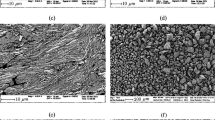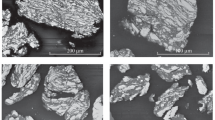Abstract
This study describes the effect of preliminary mechanical activation and SiO2 quartz content on combustion rate, maximum combustion temperature, sample elongation during combustion, compressibility of mixtures, composite particle size, phase composition, and the structural features of combustion products in a Ni–Al–SiO2 system. In Ni–Al–SiO2 initial mixtures, not subjected to mechanical activation, it is not possible to initiate combustion at room temperature if the mass content of SiO2quartz exceeds 10%. Preliminary mechanical activation of the Ni–Al–\(x\)SiO2reaction mixture expands the limit of quartz content in the mixture, at which it is possible to realize the combustion of pressed samples at room temperature, up to 40%. The burning rate and sample elongation during combustion increase significantly after the reaction mixtures are mechanically treated, and the relative density of the samples, obtained at a fixed pressing pressure, decreases. The increasing quartz content in the Ni–Al–\(x\)SiO2reduces the combustion rate, the maximum combustion temperature, and the sample elongation during the combustion of both the initial and mechanically activated mixtures. Moreover, as the quartz content increases, so does the sample density reached at a fixed pressing pressure in the case of initial mixtures, while the density in the case of mechanically activated mixtures is virtually not affected. The increasing quartz content also reduces the composite particle size after mechanical activation and increases the number of phases formed in the reaction products. An explanation for most of the observed relationships is proposed.






Similar content being viewed by others
REFERENCES
C. Suryanarayana, “Mechanical Alloying and Milling," Prog. Mater. Sci. (1–2), 1–184 (2001).
V. N. Sanin, D. M. Ikornikov, D. E. Andreev, et al., “Cast NiAl/Ni20Al3B6 Composites by Centrifugal SHS," Int. J. Self-Propag. High-Temp. Synth. (4), 232–239 (2014); DOI: 10.3103/S1061386214040098.
J. Wang, “Mechanical Alloying of Amorphous Al—SiO2Powders," J. Alloys Comp. (1–2), 139–142 (2008).
Yu. S. Pogozhev, V. N. Sanin, D. M. Ikornikov, et al., “NiAl-Based Electrodes by Combined Use of Centrifugal SHS and Induction Remelting," Int. J. Self-Propag. High-Temp. Synth. (3), 186–199 (2016); DOI: 10.3103/S1061386216030092.
M. A. Korchagin, T. F. Grigor’eva, B. B. Bokhonov, et al., “Solid?State Combustion in Mechanically Activated SHS Systems. I. Effect of Activation Time on Process Parameters and Combustion Product Composition," Fiz. Goreniya Vzryva (1), 51–59 (2003) [Combust., Expl., Shock Waves (1), 43–50 (2003)].
M. A. Korchagin, T. F. Grigor’eva, B. B. Bokhonov, et al., “Solid?State Combustion in Mechanically Activated SHS Systems. II. Effect of Mechanical Activation Conditions on Process Parameters and Combustion Product Composition," Fiz. Goreniya Vzryva (1), 60–68 (2003) [Combust., Expl., Shock Waves (1), 51–58 (2003)].
M. A. Korchagin, “Thermal Explosion in Mechanically Activated Low-Calorific-Value Compositions," Fiz. Goreniya Vzryva (5), 77–86 (2015) [Combust., Expl., Shock Waves (5), 578–586 (2015)].
M. A. Korchagin, V. Yu. Filimonov, E. V. Smirnov, and N. Z. Lyakhov, “Thermal Explosion of a Mechanically Activated 3Ni-Al Mixture," Fiz. Goreniya Vzryva (1), 48–53 (2010) [Combust., Expl., Shock Waves (1), 41–46 (2010)].
N. A. Kochetov and S. G. Vadchenko, “Effect of the Time of Mechanical Activation of a T + 2B Mixture on Combustion of Cylindrical Samples and Thin Foils," Fiz. Goreniya Vzryva (4), 77–81 (2015) [Combust., Expl., Shock Waves (4), 467–471 (2015)]; DOI: 10.15372/FGV20150410.
N. A. Kochetov, “Combustion and Characteristics of Mechanically Activated Ni + Al Mixture: Effects of the Weight and Size of the Milling Balls," Khim. Fiz. (7), 49–54 (2016) [Russ. J. Phys. Chem. B , 639–643 (2016)]; DOI: 10.7868/S0207401X16070049.
N. A. Kochetov and S. G. Vadchenko, “Mechanically ActivatedSHS of NiAl: Effect of Ni Morphology and Mechanoactivation Conditions," Int. J. Self-Propag. High-Temp. Syn. (1), 55–58 (2012).
H. Zoz and H. Ren “Processing of Ceramic Powders Using High-Energy Milling," J. Metastable Nanocryst. Mater. (1), 955–963 (2000).
Ch.-K. Lin, Sh.-Sh. Hong, and P.-Y. Lee, “Formation of NiAl—Al2O3 Intermetallic-Matrix Composite Powders by Mechanical Alloying Technique," Intermetallics (1), 1043–1048 (2000); https://doi.org/10.1016/S0966-9795(00)00039-X.
K. Wieczorek-Ciurowa, “Mechanochemical Synthesis of Metallic–Ceramic Composite Powders," in Ceramic Nanocomposites, Ed. by R. Banerjee and I. Manna (Woodhead Publ., Cambridge, UK, 2013); https://doi.org/10.1533/ 9780857093493.3.399.
K. Wieczorek-Ciurowa and K. Gamrat, “NiAl/Ni3Al–Al2O3 Composite Formation by Reactive Ball Milling," J. Therm. Anal. Calorim. (3), 719–724 (2005); https://doi.org/10.1007/s10973-005-0955-4.
O. D. Boyarchenko, A. E. Sytschev, S. G. Vadchenko, et al., “NiAl Intermetallics Dispersion-Strengthened with Silica, Alumina, and Mullite: Synthesis and Characterization," Int. J. Self-Propag. High-Temp. Synth. (2), 83–88 (2014).
V. A. Podergin, Metallothermic Systems(Metallurgiya, Moscow, 1992) [in Russian].
A. S. Rogachev, N. A. Kochetov, V. V. Kurbatkina, et al., “Microstructural Aspects of Gasless Combustion of Mechanically Activated Mixtures. I. High-Speed Microvideorecording of the Ni–Al Composition," Fiz. Goreniya Vzryva (4), 61–70 (2006) [Combust., Expl., Shock Waves (4), 421–429 (2006)].
M. A. Korchagin, E. G. Avvakumov, G. G. Lepezin, and O. B. Vinokurova, “Thermal Explosion and Self-Propagating High-Temperature Synthesis in Mechanically Activated SiO2–Al Mixtures," Fiz. Goreniya Vzryva (6), 21–27 (2014) [Combust., Expl., Shock Waves (6), 641–646 (2014)].
S. G. Vadchenko, “Gas Emission During Combustion of Mechanically Activated Ni + Al Mixtures," Int. J. Self-Propag. High-Temp. Synth. (4), 210–214 (2016).
S. G. Vadchenko, “Gas Release During Combustion of Ti + 2B Films: Influence of Mechanical Alloying," Int. J. Self-Propag. High-Temp. Synth. (2), 89–92 (2015).
Author information
Authors and Affiliations
Corresponding author
Rights and permissions
About this article
Cite this article
Kochetov, N.A., Sychev, A.E. Effect of SiO2 Content and Mechanical Activation on Ni–Al–SiO2 Combustion. Combust Explos Shock Waves 56, 520–526 (2020). https://doi.org/10.1134/S0010508220050020
Received:
Published:
Issue Date:
DOI: https://doi.org/10.1134/S0010508220050020




